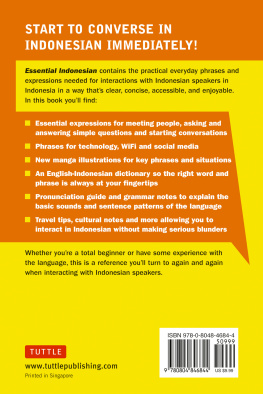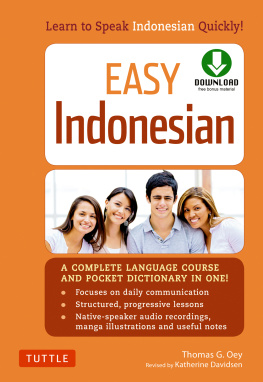Acknowledgements
The maps were provided courtesy of Mr Gary Swinton of the School of Geography and Environmental Science, Monash University.
I am also grateful for the assistance of Mr Basoeki Koesasi and Ms Yacinta Kurniasih of the School of Languages, Cultures and Linguistics of Monash University with finding materials and answering questions.
The editors of Gatra kindly gave permission to quote examples of Indonesian prose from their journal.
CHAPTER ONE
What is Indonesian?
Indonesian is "the language of Indonesia," or, in Indonesian, Bahasa Indonesia. Indonesia is a country of more than 200 million inhabitants, located in Southeast Asia (see Map la). Southeast Asia can be divided into mainland and island parts, and thus Indonesia occupies a large portion of island Southeast Asia, together with the Philippines, Malaysia and East Timor. To the east are the nation of Papua New Guinea and the various smaller states of Melanesia and Polynesia.
The land surface of Indonesia is broken up into a large number of islands, some large and many small (see Map lb). This feature gives it quite a different nature from a continental country such as the United States or Australia. The largest islands of Indonesia are (from west to east) Sumatra, Java, Kalimantan (Borneo), Sulawesi (Celebes) and the western half of New Guinea, now called Papua Barat (formerly Irian Jaya). There are several seas enclosed within the archipelago of Indonesia, for example, the Java Sea, Flores Sea, Banda Sea and Ceram Sea. And to the south there are the Arafura Sea, Timor Sea and the Indian Ocean, while to the north there are the South China Sea and the Pacific Ocean.
So it is no wonder that sometimes Indonesia has been called, somewhat romantically, Nusantara, "The Islands." On the one hand, the seas have allowed the development of hundreds of different ethnic groups inhabiting the various islands, with the result that they have their own languages and cultures, but on the other hand the seas have also provided a highway for sailing backwards and forwards, aided by the regularly alternating winds from west and east, called the monsoons.
Politically, Indonesia is a unitary republic, composed of provinces. Independence from the former colonial power, the Netherlands, was declared on August 17, 1945, and sovereignty formally transferred on December 27, 1949. The national language is Indonesian, as stated in Article 36 of the Constitution of 1945. It is interesting that this should be a matter actually regulated by law. This was necessary in view of the need to replace Dutch (and Japanese, used during the Japanese Occupation), and also to define the relationship with the many other (regional or ethnic) languages of Indonesia. The elucidation on the above article adds, "In the areas possessing languages of their own which are actively used by the people concerned (for instance, Javanese, Sundanese, Madurese and so forth), these languages will be respected and also cared for by the State. These languages are a part of the living culture of Indonesia."
Thus the adoption and use of Indonesian can be seen as a political statement, to the effect that the nation of Indonesia has one language that all the people possess in common. Indonesian is the language of unity ( bahasa persatuan). Apart from the obvious political aspect, there is also the practical necessity to have a language that everyone can learn and use, one that is not the monopoly of one group, and in this way serves as a means of communication from one end of the country to the other, "from Sabang to Merauke," as Indonesians are fond of sayingthese two towns lying at the western and eastern ends of the nation geographically. Indonesian is therefore taught in all schools and is used by all governmental agencies, as well as the national media.
What is Indonesian? We could begin by disposing of some silly misconceptions that are sometimes heard: it is not a pidgin, and it is not an artificial language. It is indeed a modern language, which fulfils all the functions of such, and yet it also has roots deep in the past. As a first step toward explaining this, we can state that Indonesian is a variety of Malay. The term "variety" does not mean "dialect" in this context. It means that Indonesian is Malay, as adopted and adapted for a special purpose, namely to be the national language of the state of Indonesia.
Malay is a language spoken and used in various parts of Southeast Asia in different forms. It is the daily language of the inhabitants of parts of Sumatra and Kalimantan, as well as the Riau Archipelago, for example, as well as of the Malay inhabitants of West Malaysia, and also the sultanate of Brunei and the Malays of Singapore. In this sense it extends across international borders. A knowledge of Indonesian is thus helpful for learning Malaysian Malay (Bahasa Malaysia or Melayu) and vice versabut do not be deceived into thinking that they are identical, as there are also many significant differences. Malay, as the national language of Malaysia, and Indonesian are clearly not the same, despite their similarities and a shared spelling system. Speakers or students of one or the other need to be aware of the differences, which in themselves make an interesting study (see Chapter 5).
MAP 1a: Southeast Asia and surrounding countries
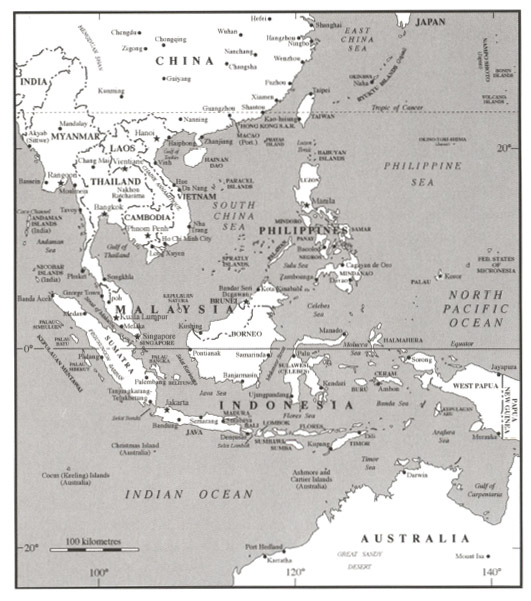
MAP 1b: The islands of Indonesia
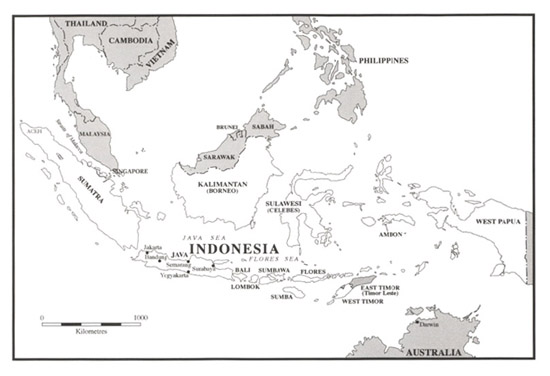
CHAPTER TEN
The Indonesian Word
Somebody beginning on the study of Indonesian will obviously be curious to find out "what it is like," that is, what its words look like and how they are strung together to make meaningful utterances or texts. The claim has sometimes been made that Indonesian is "easy," and while it is true that one can achieve satisfying results within a reasonable time, it is also a fact that there are a number of unfamiliar features, and quite a bit of effort is needed to understand, remember and apply these correctly. From the viewpoint of a speaker of English, some seemingly normal elements are missing, whereas Indonesian has some interesting ways of saying things that English does not have.
Language is not chaos, otherwise we would not be able to understand each other. There are accepted conventions or regularitiesconsensus on what conveys what meaning. But it would be wrong to expect hard and fast rules, because an exception generally seems to turn up. Indonesian has rules and exceptions too, although it may be more regular than English. Students have to master the rules and remember the exceptions if they are going to produce acceptable and comprehensible Indonesian. Speech or writing that ignores the rules just runs the risk of sounding silly, even if we can still guess the meaning.
We can make a start by introducing the concept of word-formation. Some words have no special marks, while others show changes in form in different places. For example in the English constitute, constitutes, constituted, constituting we can see a word without an ending, one with the ending "-s," one with "-d," and one with "-ing." Parallel with a change in the form of the word goes a change in its meaning. So the principle that applies is: a different form gives a different meaning. And this is valid for Indonesian too.
In some Indonesian words an element can be observed at the front of the word (this is termed a prefix), or at the end of a word (a suffix), or a combination of both. And of course there are plenty of words that are used without any addition at all; we can call these simple or underived forms.

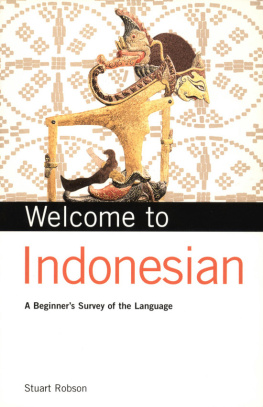


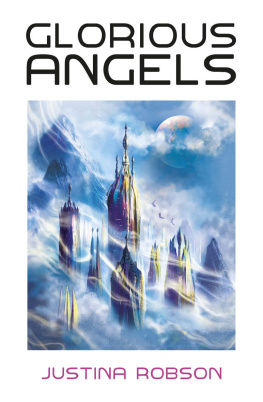


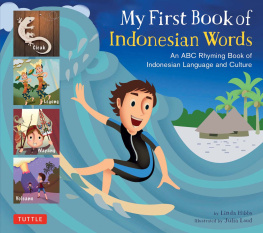
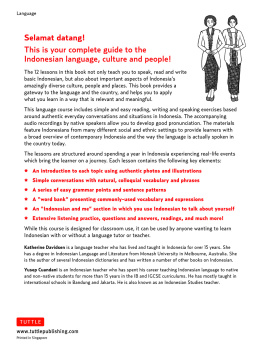

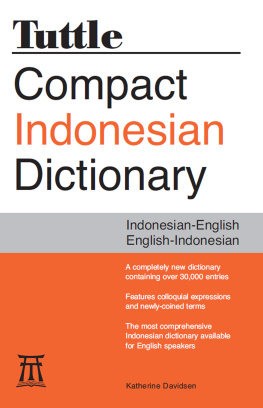
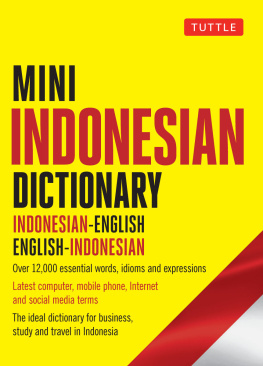
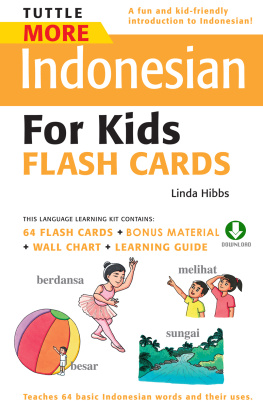

![Linda Hibbs - Tuttle Indonesian for Kids Flash Cards: [Includes Downloadable Audio]](/uploads/posts/book/362847/thumbs/linda-hibbs-tuttle-indonesian-for-kids-flash.jpg)
